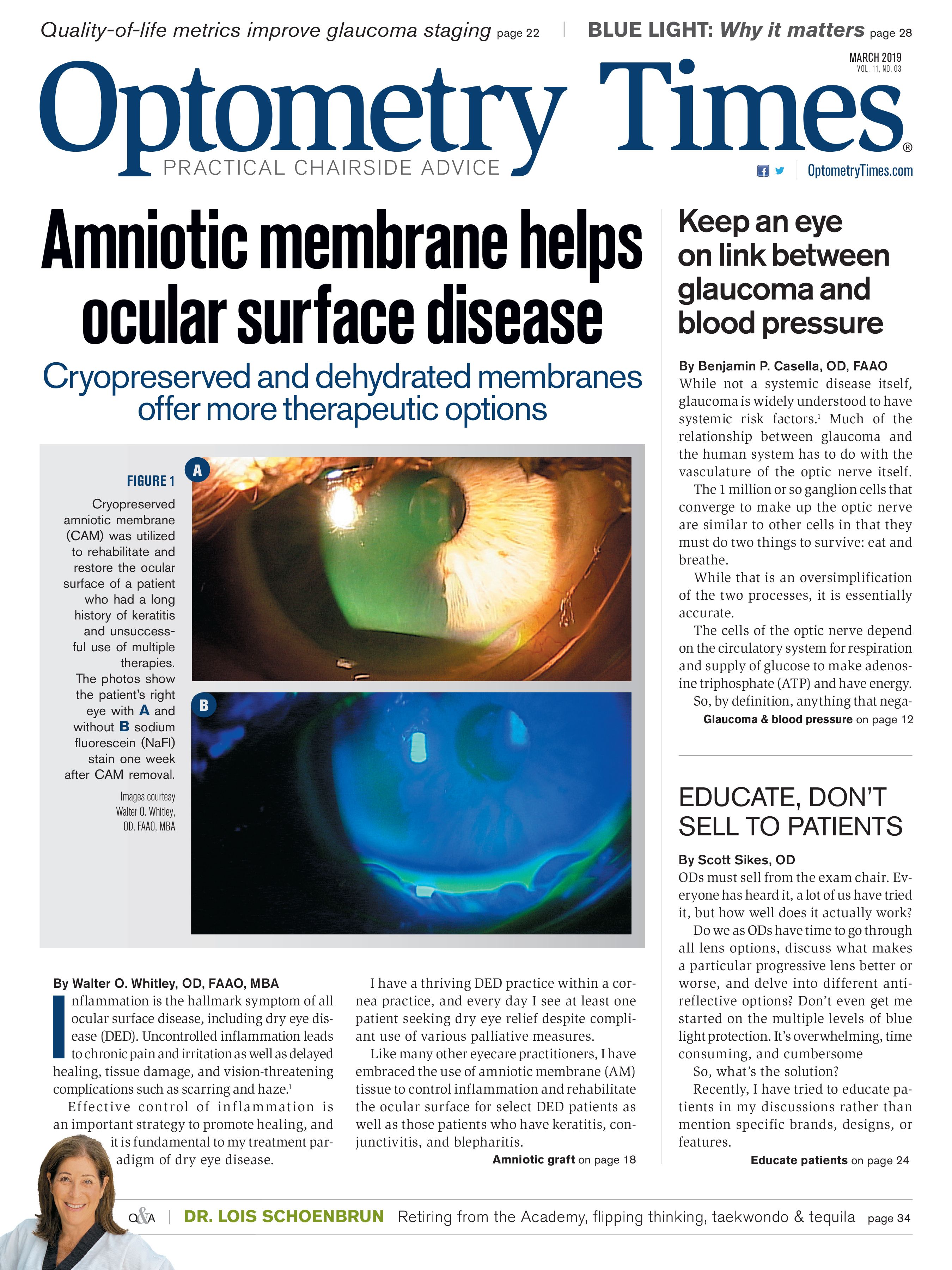Know how to care for pediatric patients diagnosed with Down syndrome

Optometrists are an important part of the care team for individuals with Down syndrome, says Marianne Boltz, OD, FAAO, of Hershey, PA, at Academy 2018 San Antonio.
More than half-60 percent-of all children diagnosed with Down syndrome have vision problems, a 2011 clinical report by the American Academy of Pediatrics1 found.
“That’s why we’re seeing them in our practices,” Dr. Boltz says.
Down syndrome diagnosis is visually confirmed by karyotype. While the individual phenotype is variable, most children develop similar features.
Common ocular findings in children with Down syndrome include:
• 50 percent with significant refractive error
• 15 percent with cataracts
• Up to 47 percent with strabismus, pseudostrabismus/epicanthus
• 33 percent with nystagmus
• Up to 75 percent with nasolacrimal duct obstruction
• 35 to 78 percent with brushfield spots
To a lesser extent, other conditions that can become apparent as a child enters early adulthood include:
• Ptosis
• Corneal ectasias
• Amblyopia
• Keratoconus
Reduced visual acuity can be a perplexing concern, Dr. Boltz says.
Even after a thorough eye exam, children with Down syndrome showing high levels of function or IQ, 20/20 vision, and no refractive error, still showed a reduced visual acuity.
Related: Reviewing pediatric primary care optometry
After conducting research, Dr. Boltz determined that reduced visual acuity in the Down syndrome population is expected.
Regardless of expectations, ODs should conduct a proper exam, rule out hyperopia, and refractive error, to name a few.
Prescribing for children
High refractive error, most commonly high astigmatism and hyperopia, has been found in children with Down syndrome. ODs prescribe for these patients as they would for any other pediatric population, Dr. Boltz says.
“We want to prevent the development of amblyopia,” she says.
ODs should prescribe for young patients with Down syndrome, particularly toddlers and preschoolers, in the following cases:
• >1.50 D anisometropia of hyperopia or astigmatism
• > 2.50 D cylinder in both eyes
• > 4.50 D hyperopia in both eyes
Behavioral component with glasses
Along with refractive error, consider behavioral components when fitting pediatric patients with Down syndrome.
Getting children to wear and continue wearing glasses can be a challenge, Dr. Boltz says. But good education and ensuring parents are on board with encouraging wear can help prevent resistance.
As a result of pediatric Down syndrome patients having a high refractive error, regular nosepads typically don’t fit these patients’ nasal bridges well, according to Dr. Boltz.
Here are other conditions often found in the Down syndrome pediatric population.
Accommodative insufficiency
Typically related to generalized hypotonia, accommodative insufficiency is a common occurrence in Down syndrome patients related to their lower muscle tone.
If this reduced accommodation isn’t addressed, it can be an additional barrier to childrens’ learning and literacy that ODs need to keep in mind, Dr. Boltz says.
Always be aware-as the kids enter school and particularly those who are not avidly reading-to conduct an accommodative test.
Giving a young patient bifocal reading glasses may also benefit if the child does a lot of reading, Dr. Boltz says.
The biggest key to watch for is if the child has a lower response to accommodation, which would result in a higher plus result, according to Dr. Boltz. This would lead to an under-accommodation response and indicate the child needs reading glasses and bifocals.
Accommodative esotropia
Uncorrected hyperopia results in accommodation in children with Down syndrome between 1.5 and 3 years of age. It is often associated with significant hyperopia.
Epicanthus
By itself, epicanthus is not a major concern, Dr. Boltz says. The condition is often misdiagnosed as true strabismus by pediatricians or family physicians.
“With an extra epicanthus, just a slight gaze to the right or to the left can make the eye look like it’s crossing in,” Dr. Boltz says, “It’s all about that education.”
Cataracts
Usually congenital, cerulean cataracts is prevalent among the Down syndrome population. Dots appearing a cerulean blue or light blue color are typically bilateral and asymmetric, according to Dr. Boltz.
The condition does not often obstruct visual acuity as a whole, although it can. It can maintain stasis or progress slowly over time.
Although not normally a concern, Dr. Boltz advises for these patients to be carefully watched.
Related: How to successfully perform a pediatric eye exam
Brushfield spots
These round focal areas appear on the anterior surface of the iris and appear white or light brown/gray.
They are likelier to develop in Down syndrome children with lightly pigmented-blue, green and hazel-irises or who are of European descent.
Keep in mind, Dr. Boltz says, these spots are not only seen in the Down syndrome population. However, they are more commonly found among these individuals than other conditions.
Strabismus
The most common form of strabismus is esotropia, which includes congenital or infantile esotropia (ET).
It is important to make sure ODs are not confusing this condition with a spasm of overconvergence, a phenomenon often seen in this population, Dr. Boltz says.
Treatment for the disorder include recommending glasses-Rx low-plus lenses- and surgery, which would be required to correct infantile ET. Having a relationship with a pediatric ophthalmologist or oculoplastic specialist will help.
Other common conditions
Aside from strabismus, additional conditions prevalent in the young Down syndrome population include:
• Accommodative esotropia
• Amblyopia
• Nasolacrimal duct (NLD) obstruction
• Keratoconus
Techniques
As for any child, NLD probing and irrigation should be the first method used by ODs. A silicone (Crawford) tube is used. If the technique fails to keep symptoms at bay long enough, additional procedures will have to be considered, Dr. Boltz says.
All children touch their eyes frequently. For those diagnosed with Down syndrome, Dr. Boltz says, ODs need to be particularly careful when conducting the NLD probing and irrigation.
The technique may be bypassed altogether, and a balloon catheter dilation could be used. This would reduce any risk for a child dislodge it or have it misplaced, Dr. Boltz says.
Related: Why my passion for pediatric exams stays personal
Any irritation-dryness, redness-of those lids and eyes will have children with Down syndrome wanting to rub, likely a little more forcefully than they should, according to Dr. Boltz.
“(ODs) may want to treat this a little sooner in these situations, and aggressively,” Dr. Boltz says.
Macula thickness
A 2015 study published in Graefe’s Archives for Clinical Experimental Ophthalmology2 researched the macular structural characteristics in children with Down syndrome in comparison to children who were not diagnosed.
The study found that, on average, the central subfield thickness (CST) in the Down syndrome group of children was larger than the CST in the second group. Results concluded the presence of abnormal macular development in Down syndrome.
Recommended exams
Pediatric tests are considered ideal when working with both children and adults diagnosed with Down syndrome or similar developmental delays.
However, binocular vision testing such as the Hirschberg test can also determine the presence of a more specific condition (strabismus) and its projected direction, frequency, and magnitude.
Another binocular vision test-Krimsky Prism Test-is also used to estimate the magnitude of strabismus. The process includes placing a correcting prism over a fixating eye until the reflex is the deviating eye is symmetric.
Related: OCT in pediatric eye disease
When to schedule exams
A child’s first eye exam is recommended at six months, Dr. Boltz says. Examining toddlers, she says, can be mirrored to “trying to put an octopus in a bag,” particularly in that 1.5 to 2.5 age range.
If results at the six-month exam appear normal, ODs will want to follow up with a child on an annual basis to evaluate for signs of amblyopia, refractive error, strabismus, or any other indicators specific to the patient’s condition.
Yearly evaluations can be followed until the age of 5. If check-up results appear normal after that, exams can be extended to every two years through adulthood.
Read more by Alex Delaney-Gesing
References:
1. Bull MJ, Committee on Genetics. Health supervision for children with Down syndrome. Pediatrics. 2011 Aug;128(2):393-406.
2. O’Brien SC, Wang J, Smith, HA, Donaldson DL, Haider KM, Roberts GJ, Sprunger DT, Neely DE, Plager DA. Macular structural characteristics in children with Down syndrome. Graefe's Arch Clin and Exp Ophthalmol. 2015 Dec;253(12):2317-2323.

Newsletter
Want more insights like this? Subscribe to Optometry Times and get clinical pearls and practice tips delivered straight to your inbox.